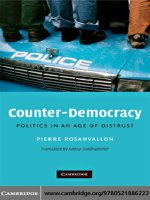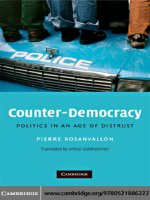0521852781 cambridge university press street justice retaliation in the criminal underworld may 2006
Bạn đang xem bản rút gọn của tài liệu. Xem và tải ngay bản đầy đủ của tài liệu tại đây (1.63 MB, 169 trang )
This page intentionally left blank
Street Justice
Street Justice: Retaliation in the Criminal Underworld
is the first systematic exploration of the phenomenon of modern-day
retaliation to be written from the perspective of currently active criminals
who have experienced it firsthand – as offenders, victims, or both.
Retaliation lies at the heart of much of the violence that plagues
inner-city neighborhoods across the United States. Street criminals, who
live in a dangerous world, realistically cannot rely on the criminal
justice system to protect them from attacks by fellow lawbreakers. They
are on their own when it comes to dealing with crimes perpetrated
against them, and they often use retaliation as a mechanism for
deterring and responding to victimization.
Against this background, Bruce Jacobs and Richard Wright draw
extensively on their candid interviews with active street criminals to
shine a penetrating spotlight on the structure, process, and forms of
retaliation in the real-world setting of urban America – a way of life that
up to now has been poorly understood.
Bruce A. Jacobs is the author of two previous books, Dealing Crack and
Robbing Drug Dealers, and is the author or co-author of approximately
twenty journal articles and book chapters. He is also the editor of
Investigating Deviance and the recipient of competitive grant funding
from the Harry Frank Guggenheim Foundation.
Richard Wright is the co-author of four previous books, including
Armed Robbers in Action and Burglars on the Job, which won the
1994–1995 Outstanding Scholarship in Crime and Delinquency Award
from the Society for the Study of Social Problems. He is also the coeditor of the Sage Handbook of Fieldwork and author or co-author of
approximately fifty journal articles and book chapters. He has been the
recipient of competitive grant awards from the National Institute of
Justice, Harry Frank Guggenheim Foundation, National Consortium on
Violence Research, Irish Research Council for the Humanities and
Social Sciences, and the Icelandic Research Council.
Cambridge Studies in Criminology
Editors
Alfred Blumstein, H. John Heinz School of Public Policy and
Management, Carnegie Mellon University
David Farrington, Institute of Criminology, Cambridge University
Other books in the series:
Life in the Gang: Family, Friends, and Violence, by Scott Decker and
Barrik Van Winkle
Delinquency and Crime: Current Theories, edited by J. David Hawkins
Recriminalizing Delinquency: Violent Juvenile Crime and Juvenile
Justice Reform, by Simon I. Singer
Mean Streets: Youth Crime and Homelessness, by John Hagan and Bill
McCarthy
The Framework of Judicial Sentencing: A Study in Legal Decision
Making, by Austin Lovegrove
The Criminal Recidivism Process, by Edward Zamble and Vernon
L. Quinsey
Violence and Childhood in the Inner City, by Joan McCord
Judicial Policy Making and the Modern State: How the Courts Reformed
America’s Prisons, by Malcolm M. Feeley and Edward L. Rubin
Schools and Delinquency, by Denise C. Gottfredson
The Crime Drop in America, edited by Alfred Blumstein and Joel
Wallman
Delinquent-Prone Communities, by Don Weatherburn and Bronwyn Lind
White Collar Crime and Criminal Careers, by David Weisburd and
Elin Warring, with Ellen F. Chayet
Sex Difference in Antisocial Behavior: Conduct Disorder, Delinquency,
and Violence in the Dunedin Longitudinal Study, by Terrie Moffitt,
Avshalom Caspi, Michael Rutter, and Phil A. Silva
continued after the Index
STREET JUSTICE
RETALIATION IN THE
CRIMINAL UNDERWORLD
Bruce A. Jacobs
University of Texas–Dallas
Richard Wright
University of Missouri–St. Louis
cambridge university press
Cambridge, New York, Melbourne, Madrid, Cape Town, Singapore, São Paulo
Cambridge University Press
The Edinburgh Building, Cambridge cb2 2ru, UK
Published in the United States of America by Cambridge University Press, New York
www.cambridge.org
Information on this title: www.cambridge.org/9780521852784
© Bruce A. Jacobs and Richard Wright 2006
This publication is in copyright. Subject to statutory exception and to the provision of
relevant collective licensing agreements, no reproduction of any part may take place
without the written permission of Cambridge University Press.
First published in print format 2006
isbn-13
isbn-10
978-0-511-21988-7 eBook (EBL)
0-511-21988-1 eBook (EBL)
isbn-13
isbn-10
978-0-521-85278-4 hardback
0-521-85278-1 hardback
isbn-13
isbn-10
978-0-521-61798-7 paperback
0-521-61798-7 paperback
Cambridge University Press has no responsibility for the persistence or accuracy of urls
for external or third-party internet websites referred to in this publication, and does not
guarantee that any content on such websites is, or will remain, accurate or appropriate.
Contents
Acknowledgments
page ix
Preface
xi
1
Background and Methods
1
2
The Retaliatory Ethic
25
3
A Typology of Criminal Retaliation
45
4
Gender and Retaliation (with Christopher Mullins)
75
5
Imperfect Retaliation
101
6
Retaliation in Perspective
123
Works Cited
137
Index
149
vii
Acknowledgments
Contrary to popular belief, academic scholarship is not a lonely
enterprise; at least we have not found it to be so. Throughout the
writing of this book, we received help, advice, and support from
numerous friends and colleagues. We would like especially to thank
Eric Baumer, Robert Faulkner, Janet Lauritsen, Bridgette Mack,
Rick Rosenfeld, and Volkan Topalli for their wise and patient
counsel. Whatever its shortcomings, our book is much better for
their constructive comments and criticisms.
Allison Deutsch compiled the index with the sensitivity and
insight that have become her hallmarks as a scholar.
The research on which this book is based was funded by a grant
from the Harry Frank Guggenheim Foundation. We are required to
state that the points of view or opinions expressed herein are ours
and do not necessarily reflect those of the Foundation, though the
research that gave rise to our views would not have been possible
without its financial backing. It took guts to fund such a
controversial piece of work, and we are grateful to the Foundation
for its support.
Chapter 3 was adapted from Jacobs, B. (2004), ‘‘A typology of
street criminal retaliation,’’ Journal of Research in Crime and
Delinquency, Vol. 41, No. 3, pp. 295–323, copyright ª 2004.
Reprinted with kind permission of Sage publications. Chapter 4 is a
revised version of Mullins, C., Wright, R., and Jacobs, B. (2004),
‘‘Gender, streetlife and criminal retaliation,’’ an article originally
published in Criminology, Vol. 42, No. 4, pp. 911–940, copyright ª
ix
acknowledgments
2004. Reprinted with kind permission of Criminology (The
American Society of Criminology).
Finally, Ronald Cohen edited our manuscript with consummate
skill, helping us bring to life the hidden world of street justice. The
bonus for us is that he did so with patience, tact, and respect for our
work. For that, we owe him a special debt of gratitude.
x
Preface
Admit it. When someone wrongs you, you want to get back at them.
Despite Biblical injunctions to turn the other cheek, most of us are
reluctant to do so. The urge to get even is so ingrained in the popular
imagination that it has spawned a whole genre of Hollywood
movies in which a peace-loving hero is driven to avenge the harm
done to a loved one in an explosion of pent-up rage. Think of old
classics like Death Wish, Billy Jack, or The Outlaw Josie Wales.
Such films were popular because they tapped into a deep-seated
human desire to see the good deliver justice to the bad, vanquishing
evil once and for all.
The real world of retaliation, however, is seldom as neat and
clean as Hollywood would have us believe. It often is difficult to
distinguish the good guy from the bad guy in disputes that take place
beyond the reach of formal law. Short of death, few such conflicts
are ever really settled for good, with each new strike generating a
counter-strike in a deepening cycle of instability and violence.
Indeed, formal law emerged in part to ameliorate the chaos
engendered by retaliation, by replacing informal dispute resolution
with a more institutionalized mechanism of social control.
Street criminals, however, cannot realistically rely on formal law
to settle their disputes. Despite being especially vulnerable to being
preyed on, it is difficult for them to stake a legitimate claim to victim
status. Even if the police were willing to believe that street criminals
had been victimized – which seems unlikely – strong cultural
proscriptions not to cooperate with authorities militate against
offenders making an official crime report. Practically speaking,
xi
preface
then, street criminals must themselves assume primary responsibility
for righting perceived wrongs committed against them.
Despite its preeminent role in regulating disputes between and
among street criminals, retaliation has received scant attention from
criminological researchers. Existing studies explore retaliation only
tangentially, with little or no consideration of its situational and
contextual dynamics. Even when retaliation is examined in its own
right, the circumstances in which payback is enacted typically
receive less attention than the factors that mediate the availability of
law. As a result, the structure, process, and forms of retaliation in
the real-world setting of urban American street crime remain poorly
understood.
This book explores the face of modern-day retaliation on the
streets of St. Louis, Missouri, from the perspective of currently active
criminals who have experienced it firsthand, as offenders, victims,
or both. Chapter One introduces the subject of criminal retaliation,
explains why it is important within and beyond criminology, and
outlines the research that will inform subsequent chapters. Chapter
Two explores the retaliatory ethic among street criminals and the
vocabulary of motive that offenders adopt to justify its role as the
preferred mode of extra-legal social control. The specter of counterretaliation, and how grievants perceive and manage this threat, also
will be considered. Chapter Three examines the structure, process,
and contingent forms of retaliation, offering a typology to organize
the data. Chapter Four considers the ways in which gender shapes
the context and dynamics of retaliatory events for both male and
female street criminals. Chapter Five investigates the phenomenon
of ‘‘imperfect’’ retaliation – acts of reprisal committed against
parties not responsible for the instigating affront. The reasons for
imperfect retaliation and their implications for crime displacement
beyond the law will be explored specifically. Chapter Six addresses
conceptual issues in retaliation and pays special attention to the role
of criminal reprisal in the spread and containment of urban violence.
Throughout the book, and especially in the last chapter, we
endeavor to be sensitive to the policy implications of our data.
xii
one
Background and Methods
The skinny young drug dealer sitting across from us had been
robbed at gunpoint. Someone had lobbed a brick through the
passenger-side window of his car, shoved a pistol in his face, and
demanded his money, drugs, and keys. He handed everything over
without protest. The robber had the ups on him – what else could he
do? The dealer could not see the offender’s face – he was wearing a
mask – but he recognized his voice and the distinctive paint-stained
boots on his feet. He knows who did it. Now, he wants to get even.
The pursuit of justice animates social life. ‘‘[T]he question of
what people are entitled to is fundamentally a question about what
it means to be a person’’ (Miller 2001:545; see also Furby 1986). Is
it any wonder that people are hypersensitive to infringements on
what they believe should be theirs by right, and feel compelled to get
even with anyone who dares to deprive them of what they regard as
their just due?
The need to retaliate arises from a basic sense of injustice, the
feeling that you have been unfairly subjected to a force against
which you are situationally powerless to act (Marongiu and Newman 1987:9). As ‘‘gifts of negative moral value’’ (Miller 1993:16),
injustices create imbalances that cry out for elimination. Though
these injustices vary in nature and severity, all deprive grievants of
the respect that they believe is owed them (Miller 2001).
Retaliatory urges belie the powerful human need to ‘‘get even’’
(Marongiu and Newman 1987). This desire for payback has been
called a universal drive, an instinct, for want of a better term, on the
same conceptual plane as hunger or thirst (see, for example, Fromm
1973). We may not wish to acknowledge this ‘‘feral force’’ within us
1
street justice
(Seton 2001), but it is there nonetheless, poised and ready to elicit
responses against perceived encroachments both major and minor.
Someone wrongs you, and you experience a spontaneous urge to
strike back, quickly, reflexively, with no qualms. All of us have felt
this urge at one time or another. Many of us have acted on it.
The retributive urge has a vicarious dimension as well. The
righteous feeling that third parties experience from witnessing
wrongdoers get their just desserts often rivals or exceeds the impulse
to see victims compensated. As Miller (2001:535) notes, ‘‘[H]owever
great the empathy that people have for victims of injustices, their
anger toward the perpetrator is generally greater.’’ It is not uncommon, for example, for so-called Good Samaritans to leave crime
victims bleeding on the sidewalk as they instead chase down and
tackle the person responsible for inflicting those injuries (Huston,
Geis, and Wright 1976).
Vicarious or direct, revenge is uniquely transportive. It represents
a return to the site of an ‘‘earlier moment of pain.’’ The objective, of
course, is to neutralize that pain for, in its perpetual remembrance,
there ‘‘can be very little freedom to accept the future’’ (Barreca
1995:9). Such neutralization is obviously impossible because harm –
once inflicted – can never be undone. Revenge, therefore, takes on a
certain ‘‘magical’’ quality (Fromm 1973; Marongiu and Newman
1987).
People have long taken the law into their own hands in an attempt
to right perceived wrongs. Historically, vigilantism served as the
principal method by which disputes were resolved. It remains
the prevailing mode of social control in traditional, honor-based
societies, triggering penalties that can be notably violent. ‘‘Honor
societies,’’ as Gould (2003:126–127) remarks, ‘‘are renowned . . . for
the practice of blood revenge.’’ He continues:
Social scientists interested in explaining the practice . . . have most
often seen it as a form of dispute resolution – a tool for settling
conflicts in situations lacking a formalized, third-party justice
system. It is now commonly argued that the threat of revenge is a
functional alternative to the threat of third-party punishment;
2
background and methods
according to this view, social groups, usually families of some
kind, can deter rival groups by making it clear that the kin of
someone killed during a dispute will punish the offender and
possibly others in the offender’s group.
Be that as it may, the retaliatory ethos that underpins traditional
blood feuds is backward-looking in that it encourages individuals to
bear grudges, to remember past wrongs, and to disregard their
future well-being in favor of getting even (Gould 2003).
As societies modernize, there is a move away from informal
methods of dispute resolution toward a more bureaucratized system
of justice that allows individuals to transfer their grievances to a
formal authority and thereby get on with their lives. As Gould
(2003:22, 170) puts it: ‘‘Honor systems encourage people (especially
men) to react quickly, definitively, emotionally, and often physically
to insults or other transgressions, whereas the modern bureaucratic
world emphasizes dispassionate, rational deliberation and long-term
planning. . . . [In modern societies,] prudence and peacemaking
demand . . . that wronged persons abandon the past and embrace
the future.’’ Even in modern societies with highly formalized systems
of justice, vestigial contexts inevitably remain. The street criminal
underworld is perhaps prototypical in this regard: It exists largely
beyond the reach of formal law and continues to lionize honor –
often in the guise of ‘‘respect’’ – as something to be protected at
all cost.
Offenders who fall victim to crime are reluctant to go to the
police because, among other things, doing so could expose their own
illegal activities to official scrutiny. But even if criminal victims
could make a police report without fear of implicating themselves
(say, through a guarantee of immunity from prosecution), few
probably would exercise this option; most realize that the government cannot enforce illegal contracts. Moreover, the inherently
conflictual relationship between street criminals and law-enforcement personnel, coupled with an informal code that prohibits
offenders from cooperating with authorities as a matter of honor,
militates against turning to the police for help.
3
street justice
Street criminals’ desire for safety and justice are of little or no
concern to most police officials anyway. As a result, offenders are
forced to handle conflicts and disputes through a rough-and-ready
brand of self-help (Black 1983). The need for them to retaliate is
substantial because street criminals are especially vulnerable to
victimization. Living in high-crime neighborhoods, largely invisible
to the police, often carrying high-value contraband (for example,
drugs), dealing almost exclusively in cash, and regarded by virtually
everyone as deserving what befalls them, street criminals are routinely exploited by other predators. The only realistic mechanism
available to them for responding to such attacks and deterring
future ones is exacting their own justice.
Cultural imperatives reinforce the need for retaliatory justice. In
the volatile world of street crime, projecting an image of selfreliance dominates almost all other concerns. Inter-personal
encounters are loaded with meaning, especially disputes, which
are proving grounds for character (Oliver 1994; Anderson 1999).
Violations that do not elicit retaliatory responses label the victim as
being weak, and on the street, there is no place, or mercy, for
cowards (Topalli, Wright, and Fornango 2002).
For precisely this reason, alerting the authorities is not a realistic
option for criminals who have been victimized. Calling the police
stigmatizes you as someone who cannot handle your own business.
Cooperation with the authorities also may label you as a snitch, and
in street culture there is no more reviled status. ‘‘[A] snitch is the
worst thing you can be,’’ one street criminal proclaimed, ‘‘inside or
outside of jail’’ (quoted in Rosenfeld, Jacobs, and Wright
2003:298). Being labeled as a snitch, deservedly or not, can result in
your being targeted for retaliatory strikes, and many an informant
has experienced the wrath of jilted street criminals looking for
payback against the ‘‘rats’’ who supposedly implicated them.
The paradox of criminal self-help is that it occurs in a setting
inundated with law enforcement. Zero-tolerance policing in its
many guises – saturation patrol, crackdowns, sweeps, covert
operations, and the like – is emblematic of the War on Crime that
has taken over the nation’s urban neighborhoods. Such tactics are
4
background and methods
divisive at best, sinister at worst, but all foment a general perception
that the police are the enemy – individuals who abuse their power
and exercise discretion for purposes best considered nefarious (see,
for example, Miller 1996). When the source of a sanction threat is
perceived as being unjust, the sanction loses its assumed legitimacy
and generally cannot have the desired deterrent effect. Worse yet,
attempts to impose an illegitimate sanction may actually encourage
individuals to defy it and commit more crime (Sherman 1993). At
the least, this will decouple the link between formal and informal
social control – the building blocks of collective efficacy and crime
containment – and allow instability to thrive. This reinforces the
code of the street and the retaliatory ethic that drives it.
Although retaliatory acts committed in the name of social control are a widely recognized feature of the urban street scene, they
seldom appear in official police reports despite the fact that many of
them clearly represent serious violations of the law. An understanding of retaliation as both a social process and a control process
is important, however. It is clear that a substantial number of
assaults, robberies, and other forms of serious criminal behavior are
a direct consequence of retaliation and counter-retaliation (Topalli,
Wright and Fornango 2002). As such, retaliatory conflicts contribute significantly to the violent reputation and reality of many
high-crime neighborhoods. Retributive threats play a crucial role in
shaping the interactional environment in which street-level behavior
is enacted, motivating offenders to acquire firearms for both retribution and protection. This leads to a concomitant increase in the
number of firearms on the street, the diffusion of firearms to persons
not directly involved in predatory crime, and an increasingly casual
use of weaponry (see Blumstein and Rosenfeld 1998; Jacobs et al.
2000). Retaliation fuels official rates of serious violence, resulting in
injuries or deaths that cannot easily be covered up (Jacobs, with
Wright 2000). This may trigger a contagion of violence, whereby
increasing numbers of disputants get sucked into germinating spirals
of conflict. The resultant instability and chaos can have grave longterm consequences – within the street criminal underworld and
beyond it.
5
street justice
Despite the potentially destabilizing influence of retaliatory justice, knowledge of the perceptual, situational, contextual, and
interactional mechanisms that mediate its occurrence remains
incomplete. We are not the only analysts who find it startling that so
little empirical criminological research has been conducted on the
topic (Vidmar 2001:33). The absence of inquiry is all the more
striking when readers consider that most social control is informal
and that many crimes are moralistic in nature (Black 1983; Katz
1988). Retaliation represents the obvious intersection between
informal social control and moralism. It is, in the elegant parlance of
Donald Black (1983), ‘‘crime as social control.’’
Exploring the intersection between crime and informal social
control facilitates a more precise understanding of both deterrence
and the contagion-like processes through which violence is contracted and contained (Loftin 1985). If, as some have suggested, the
spread of violence represents a public health problem (Cook and
Laub 1998; Mercy, Rosenberg, Powell, Broome, and Roper 1993),
then we must identify the precise mechanisms that facilitate or
impede its transmission from one event to another. Not only might
this lead to a better understanding of how cycles of urban violence
are promoted and intensified, it also might suggest key points of
intervention to break these cycles before they spin out of control
(Jacobs, Topalli, and Wright 2000).
The most promising way to address these issues is to go to street
criminals themselves. They have an insider’s view of how street
crime and informal social control interact in a hidden world beyond
the law, outside the popular preoccupation of most academic
criminologists and criminal justice policymakers.
Our Study
This book explores the perceptual and situational factors that
mediate retaliatory decisions in the real-world setting of urban street
culture, where the ability to exact payback carries especially strong
sub-cultural currency. To this end, we recruited from the streets of
St. Louis, Missouri, fifty two active offenders who have participated
6
background and methods
directly in retaliation and interviewed them at length about their
behavior, paying particular attention to factors that condition the
etiology and enactment of street justice. By attending to what Katz
(1988:3) calls the ‘‘foreground of criminality’’ – that is, the perceptual mechanisms through which retaliatory acts come to be
contemplated and carried out – we will illuminate links between
criminal lifestyles, victimization, and the immediate social and
situational contexts in which decisions to strike back are activated.
Retaliatory decisions, after all, are not made in a socio-cultural
vacuum; they are embedded in an ‘‘ongoing process of human
existence’’ (Bottoms and Wiles 1992:19; see also, Jacobs and Wright
1999).
Our exploration of criminal retaliation is anchored conceptually
at the nexus between rational-choice theory and phenomenological
interactionism (see Wright and Decker 1994). Rational choice is a
paradigm that holds that all human decisions emanate from a process of careful calculation and assessment. Actors weigh the costs
and benefits of anticipated behavior, and proceed when the latter
exceed the former. While this ultimately requires actors to make a
subjective evaluation of prevailing conditions, decisions revolve
around a set of external objective properties that, to a greater or
lesser extent, are predictable. In contrast, phenomenological interactionism attends more to the transient internal emotional states
that underpin decision-making in the offending moment (Wright
and Decker 1994). Sensual concerns predominate, and cool
rationality gives way to hot ‘‘emotionally-laden’’ cognition (see, for
example, Exum 2002). This often results in less than optimal
choices, though at the time they may appear optimal to the party
making them.
Blending rational-choice theory and phenomenological interactionism, then, permits us to assess the simultaneous impact on
retaliatory decisions of hard, verifiable contingencies (for example,
costs, benefits, physical obstacles) and subjective emotional forces
(Jacobs, with Wright 2000). This approach is critical because the
structure of reprisal, its process, and contingent forms inevitably
reflect elements of both calculation and emotion. Ascertaining the
7
street justice
relative contribution of each has important implications for understanding the role that retaliation plays in facilitating – and constraining – the spread of street crime and violence.
Research Site
The research on which this book is based was conducted in
St. Louis, Missouri. Once a manufacturing hub for the Midwest and
Mississippi River Valley, the city is now in serious economic trouble.
The revitalization that swept through so many other rustbelt cities in
the 1980s and 90s largely bypassed St. Louis, a city with a long and
complicated history of regional political fragmentation that has
habitually inhibited economic development. Lucrative blue-collar
jobs, once the principal source of high-paying employment in the
city, have vanished, and nothing of real consequence has replaced
them. Residents of St. Louis have fled, and continue to flee, to the
surrounding suburbs, taking much of the tax base with them. In the
forty years following World War II, St. Louis lost more than half
its population (Bray 2003). A significant portion of the remaining
population is poor, aging, and in chronic need of expensive social
services.
Against this backdrop, serious crime and violence flourish.
St. Louis consistently places at or near the top of large U.S. cities in
rates of violent crimes such as armed robbery, aggravated assault,
and homicide. In 1999, for example, the city ranked first in total
crimes per capita among American cities larger than 100,000
(Hackney et al. 2000). Recent FBI statistics indicate that 2,323
serious violent crimes per 100,000 people were committed in
St. Louis – over four times the national average (UCR 2002). The
city’s murder rate (nearly seven times the national average), robbery
rate (over six times the national average) and aggravated assault rate
(over four times the national average) are among the highest in the
nation. Property crime rates, including burglary, larceny, and auto
theft, are over three times the national average. Increases and
decreases in St. Louis’s violent crime rate tend to mirror those of
other U.S. cities, albeit on a different scale. This makes St. Louis an
8
background and methods
ideal laboratory for investigating the dynamics and processes relevant to violent criminal events, including retaliation (see Rosenfeld
and Decker 1996).
Sample and Recruitment
As already noted, data for this study were drawn from in-depth
qualitative interviews with fifty two active street offenders.
A number of these individuals were interviewed more than once,
and one of them had to be eliminated from the sample because of
the poor quality of the interview, producing a total of sixty six
separate interviews. Interviews took place over a 22-month period
that began in summer 2001. The mean age of respondents was 27
years (the median was 26). Forty respondents were male, twelve
were female; respondents, on average, had completed 11.6 years of
formal education; twenty five of the fifty two respondents claimed to
be working in some legitimate capacity at the time they were
interviewed; thirty six respondents reported having children; five
of the fifty two respondents were married. All respondents were
African-American.
We chose to employ qualitative data-collection techniques because
they are ideally suited to the study of ‘‘hidden populations’’ –
groups difficult to access by virtue of their stigmatizing or illegal
behaviors, which members actively work to conceal from outsiders
(see Spreen 1992). Qualitative methods permit investigators to
explore the conduct norms that underpin the behavior of hidden
populations. In addition, such methods reveal emergent behavioral
and decision-making processes, an especially vital objective when
the people or setting being examined reside at the ‘‘forefront of
broader trends’’ that require real-time identification for the formulation of effective social policy (see Golub and Johnson
1999:1737).
Studying criminals ‘‘in the wild’’ is not an easy task. Offenders
have strong incentives to hide their identity and activities from
outsiders. This makes them difficult to find, and, once located, they
often are reluctant to cooperate. Such reluctance is reassuring in the
9
street justice
sense that it helps to confirm potential interviewees’ deviant status
as lawbreakers. For street criminals, the price of indiscretion can be
high – lost freedom, reputational damage, even death – so their
suspicion of strangers is understandable. Perhaps the most common
suspicion that street criminals harbor about outsiders is that they are
undercover police of some sort. As Sluka (1990:115) notes, ‘‘It is
difficult to find an [ethnographer] who has done fieldwork who has
not encountered this suspicion.’’ This is hardly surprising; in the
street criminal underworld it is a ‘‘basic cultural rule . . . to treat
everyone as a snitch or the man [police] until proven otherwise’’
(Agar 1973:26).
Many criminologists opt to study incarcerated criminals instead
of active offenders because doing so can be easier and more convenient. Finding prisoners obviously is not difficult (though negotiating the bureaucratic obstacles necessary to gain access to them
may be), and the tedium of prison life ensures that many of them
will cooperate, if for no other reason than to break the monotony of
their daily routine. The drawback to prison-based research is that
jailed offenders represent a certain type of criminal – those who
have been caught and successfully prosecuted. By definition, this
makes them unsuccessful criminals and perhaps different from
offenders who have managed to evade capture. Beyond this, prisoners often bring an agenda to the interview setting that can compromise the validity and reliability of any information they provide
to researchers. No matter how much they are assured otherwise,
incarcerated offenders often associate researchers with prison staff
and other criminal justice functionaries who can provide benefits or
mete out punishment. Bias results when prisoners tell researchers
what they think they want to hear in the hope of receiving a reward
or avoiding a penalty. Many inmates steadfastly believe that ‘‘what
they say to researchers will get back to the authorities and influence
their chances for early release. And even if this does not seem likely,
why take the chance? Consequently, inmates . . . put the best possible spin’’ on their previous activities (Wright and Decker 1997:4).
For these reasons, criminologists have long ‘‘suspected that offenders do not behave naturally’’ in criminal justice settings (Wright
10
background and methods
and Decker 1994:5). Sutherland and Cressey (1970:68), for example, point out that ‘‘those who have had ‘‘intimate contacts with
criminals ‘in the open’ know that criminals are not ‘natural’ in
police stations, courts, and prisons and that they must be studied in
their everyday life outside of institutions if they are to be understood.’’ Polsky (1967:123) similarly cautions that ‘‘we can[not]
afford the convenient fiction that in studying criminals in their
natural habitat, we . . . discover nothing really important that
[cannot] be discovered from criminals behind bars.’’ Human beings,
after all, are animals. They are no more likely to behave naturally in
captivity than polar bears or aardvarks. Imagine going to a zoo to
study the hunting strategies of lions.
As a practical matter, jailed offenders also have a tendency to
recollect their crimes as having been far more rational than they
really were. Their rationality is reconstructed ‘‘in a manner consistent with what ‘should have been’ rather than ‘what was’ ’’
(Cromwell et al. 1991:42), an artifact of the controlled setting of the
prison interview room, coupled with the distorting lens of time that
can imbue even the craziest of behaviors with purpose and meaning.
The ‘‘prison environment is detached from [the] temptations and
pressures’’ of street life, so research conducted in such a setting
inevitably misses the powerful role those forces play in shaping
offender behavior (Wright and Decker 1994:213).
Respondents were located through the efforts of a specially
trained field worker who has collaborated with us on several previous projects, going back five years. When we first met him, this
person was an active criminal and a respected figure in the St. Louis
underworld. His direct involvement in crime attenuated over the
course of time – he got older and wiser and, by his own admission,
tired of running the streets the way he used to – but he retained a
solid reputation among his criminal peers for integrity and trustworthiness. Walker and Lidz (1977:115) remind us that access to
clandestine worlds requires an ‘‘individual who will establish the
[researcher’s] credentials [and who is] well thought of by the other
participants in the system.’’ Without such a person, research of the
kind undertaken here has little chance of success.
11









